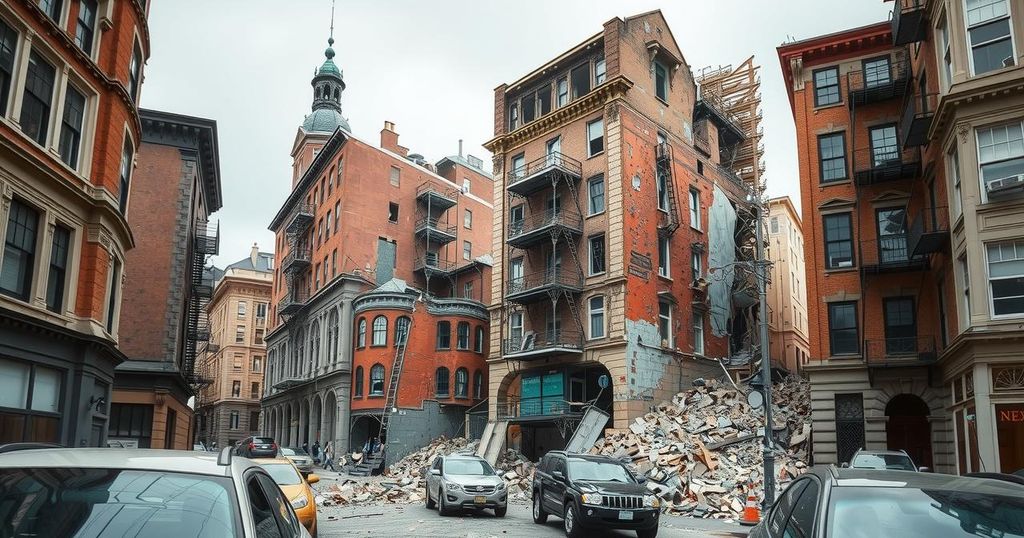World news
AMERICAS, ASIA, BRITANNICA, CALIFORNIA, CHINA, CHINATOWN, CITY HALL, COOS BAY, EMERGENCY RESPONSE, EUROPE, EVACUATIONS, FRANCISCO, GOLDEN GATE PARK, HUMBOLDT, HUMBOLDT COUNTY, JAPAN, LOS ANGELES, MARKET DISTRICT, MEXICO, MONTGOMERY STREET, NATURAL DISASTER, NATURAL DISASTERS, NORTH AMERICA, NORTH BEACH, OLD CITY, OREGON, PALACE HOTEL, PARAGUAY, PHILIPPINES, RUSSIAN HILL, SALINAS, SAN ANDREAS, SAN ANDREAS FAULT, SAN BENITO, SAN FRANCISCO, SAN JOSE, SAN JUAN BAUTISTA, SANTA ROSA, SOUTH AMERICA, SOUTH OF MARKET, TELEGRAPH HILL, UNITED STATES
Ethan Kim
0 Comments
The Devastating Impact of the 1906 San Francisco Earthquake
The 1906 San Francisco earthquake, occurring on April 18 at a magnitude of 7.9, caused extensive damage, leading to over 3,000 deaths and 250,000 homeless. Following the earthquake, a massive fire ravaged the city, destroying 28,000 buildings and costing an estimated $350 million. This disaster prompted significant humanitarian aid and led to resilient urban rebuilding efforts, influencing future earthquake preparedness and response.
On April 18, 1906, a catastrophic earthquake struck northern California near San Francisco, registering a magnitude of 7.9 on the Richter scale. The seismic event originated from a segment of the San Andreas Fault, spanning approximately 270 miles from San Juan Bautista to Humboldt County. The earthquake was felt widely, from Los Angeles to Coos Bay, Oregon. The consequences for San Francisco were devastating, with reports detailing extensive damage to infrastructure and property, including cable cars abruptly halting and significant destruction of landmarks such as City Hall and the Palace Hotel.
In addition to the earthquake, a massive fire ensued, wreaking havoc on the city for four days, engulfing neighborhoods such as Chinatown and North Beach. This inferno ultimately consumed about 28,000 buildings across four square miles of urban area, contributing to an estimated property loss of $350 million. Initially, the death toll was estimated at 700, but current assessments suggest over 3,000 lives were lost. Furthermore, the disaster left around 250,000 individuals homeless, many of whom sought shelter in makeshift camps within Golden Gate Park and surrounding areas.
The humanitarian response was swift, with relief efforts providing food, clothing, and millions of dollars in aid from various regions globally. Although insurance payouts topped $300 million, the endeavor to reconstruct the city was fueled by local resilience and determination. Emphasis was placed on rebuilding structures that were more resilient to earthquakes and fires, leading to innovative urban design initiatives. By 1915, San Francisco proudly showcased its recovery at the Panama-Pacific International Exposition.
Scientific investigations following the earthquake contributed significantly to seismology, particularly in understanding the elastic rebound theory, which elucidates the mechanics driving seismic activity. This pivotal disaster not only radically altered the physical landscape of San Francisco but also shaped future urban planning, engineering practices, and disaster preparedness protocols.
The San Francisco earthquake of 1906 remains one of the deadliest natural disasters in American history. Occurring on the morning of April 18, it prompted widespread destruction across northern California, most notably within San Francisco itself. The earthquake and subsequent fire led to unprecedented loss of life and property, necessitating a large-scale response from both local and international communities. The experiences gained from this disaster underscored the need for enhanced infrastructure resilience and informed the study of earthquake phenomena for future mitigation efforts. The San Andreas Fault, a major tectonic boundary, has since been recognized as a significant source of seismic activity. Investigations into the causes and impacts of this earthquake have enriched scientific understanding of geologic processes, particularly in relation to fault mechanics and urban vulnerability to seismic events.
In summary, the 1906 San Francisco earthquake was a profound natural disaster that resulted in extensive physical destruction, a substantial loss of life, and a long-term impact on disaster management practices and urban planning. The subsequent efforts to rebuild the city emphasized resilience against future earthquakes, demonstrating the tenacity of the survivors. The event has served as a crucial reference point for seismology and emergency response strategies, shaping policies and preparedness efforts to this day.
Original Source: www.britannica.com




Post Comment